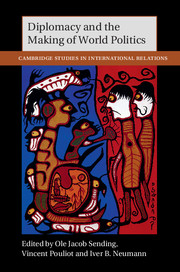Book contents
- Frontmatter
- Contents
- Contributors
- Acknowledgments
- Introduction
- Part I Making of international institutions
- Part II Making international cooperation
- Part III Diplomacy as a contested terrain
- 7 Diplomacy as economic consultancy
- 8 US military diplomacy in practice
- 9 Diplomats and humanitarians in crisis governance
- Conclusion: Relationalism or why diplomats find international relations theory strange
- Bibliography
- Index
- Cambridge Studies in International Relations
8 - US military diplomacy in practice
from Part III - Diplomacy as a contested terrain
Published online by Cambridge University Press: 05 September 2015
- Frontmatter
- Contents
- Contributors
- Acknowledgments
- Introduction
- Part I Making of international institutions
- Part II Making international cooperation
- Part III Diplomacy as a contested terrain
- 7 Diplomacy as economic consultancy
- 8 US military diplomacy in practice
- 9 Diplomats and humanitarians in crisis governance
- Conclusion: Relationalism or why diplomats find international relations theory strange
- Bibliography
- Index
- Cambridge Studies in International Relations
Summary
Airmen understand Airmen, and that's where the partnership begins.
General Mark A. Welsh, Chief of Staff of the US Air Force, speech to the Air Force Association Air Power Working Group, Washington DC, May 20, 2013. Quoted with his permission.In their Introduction to this volume, Sending, Pouliot, and Neumann argue that “if we want to account for changes in diplomatic practices by virtue of the proliferation of actors involved in diplomatic work, the question of how and why different actors do diplomacy must be central.” In this chapter, we discuss US defense diplomacy with the aim of providing answers, however partial, to this question.
The significance of studying US military diplomacy should require little elaboration. The United States is currently the dominant military power in the world. Its power projection capabilities are unprecedented in human history. As Barry Posen argues, for the past few decades the US military has possessed “command of the global commons,” that is, it “gets vastly more military use out of the sea, space, and air than do others … it can credibly threaten to deny their use to others … and … others would lose a military confrontation for the commons if they attempted to deny them to the United States.”
This condition rests on raw US military might, but “two important Cold War legacies contribute to U.S. command of the commons – bases and command structure.” Indeed, US primacy “is further secured by the world-wide U.S. base structure and the ability of U.S. diplomacy to … secure additional bases and overflight rights.” Bases and overflight rights, though, reflect simply one dimension of the extensive system of alliances and partnerships built by the United States. Indeed, a significant degree of contemporary global security governance operates within and through this US-centered network.
Our analysis draws on a variety of sources, including interviews and the personal experiences of the authors. It builds on two basic wagers: first, “routine diplomacy is a matter of network construction and maintenance” and second, the content of those networks – the meanings actors attach to or impose on them – reflects and shapes the conduct of diplomacy. In this sense, an analysis of the meanings that US military and civilian officials attach to their diplomacy provides insight into the practice of US primacy.
- Type
- Chapter
- Information
- Diplomacy and the Making of World Politics , pp. 220 - 255Publisher: Cambridge University PressPrint publication year: 2015
- 5
- Cited by

